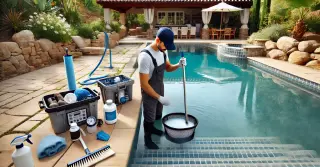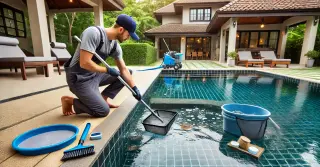Pool Chemical Balance Dallas SD

Ensuring the right chemical balance is crucial for a safe and healthy swimming environment. Balanced chemicals inhibit algae and bacteria, maintain clear, clean water, and protect the pool's surface and equipment.
- Optimal pH Balance: The pH balance in your pool is a measure of its acidity or alkalinity. The ideal pH range is between 7.2 and 7.6. If the pH is too low, the water becomes acidic, which can cause skin irritation and corrosion of pool equipment. High pH levels make the water alkaline, leading to cloudiness and scaling. Regularly testing and adjusting the pH levels is vital for swimmer comfort and safety.
- Monitoring Chlorine Levels: Chlorine is a key component in pool sanitation, destroying bacteria, algae, and other harmful pathogens. Optimal chlorine levels range from 1 to 3 ppm. Insufficient chlorine results in unsanitary conditions, promoting bacteria and algae growth. Excessive chlorine leads to skin and eye irritation and cause a strong chlorine smell. Consistently monitoring and adjusting chlorine levels ensures sanitation and comfort.
Managing Total AlkalinityTotal alkalinity plays a vital role in pool water balance. Alkalinity acts as a buffer for pH levels, avoiding sudden pH changes. Proper total alkalinity levels range from 80 to 120 ppm.
- Avoiding pH Fluctuations: Proper alkalinity levels help stabilize pH levels, preventing rapid pH shifts that cause skin irritation and surface damage. If alkalinity is too low, pH levels can fluctuate wildly, making balance maintenance challenging. Excessive alkalinity results in cloudy water and scaling. Regularly testing and adjusting alkalinity levels is crucial for stable and balanced water.
- Balancing Calcium Levels: Calcium hardness refers to the amount of dissolved calcium in the pool water. The ideal range for calcium hardness is between 200-400 ppm. Low calcium levels result in corrosive water, harming surfaces and equipment. If calcium levels are too high, it can cause scaling on pool surfaces and cloud the water. Consistently monitoring and adjusting calcium hardness is essential for pool protection and clear water.
Proper Chemical Use and StorageUsing and storing pool chemicals safely is essential for both safety and effectiveness. Keep chemicals in a cool, dry location, away from sunlight, children, and pets. Follow the manufacturer's instructions for proper dosing and application.
- Proper Chemical Measurement and Mixing: Precise measurement of pool chemicals is crucial for maintaining balance. Using too much or too little can disturb chemical balance and water quality. Use a clean, dry measuring cup or scoop and avoid mixing chemicals directly. Mix in water as needed, following guidelines carefully.
- Awareness of Chemical Reactions: Certain chemicals can react dangerously if mixed. For example, chlorine and acid should never be mixed. Being aware of these interactions helps prevent accidents and ensures safe handling. Store chemicals separately and handle each with care to avoid harmful reactions.
Ensuring the right chemical balance in your pool is vital for a safe, clean, and pleasant swimming experience. By frequently testing and balancing pH, chlorine, alkalinity, and calcium, you ensure optimal water quality.
Safe handling and storage of pool chemicals enhance the health and safety of your pool.




